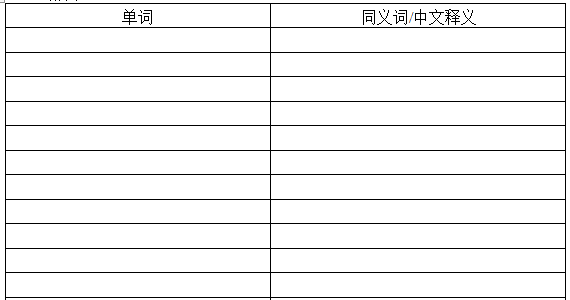摘要:新托福阅读能力是考试主办方重点考察的方向之一。除了在托福阅读部分考察外,在其他单项中也会出题考察。因此这需要考生们学习更多实用技巧来应对考试的挑战,大家在平时一定要多加练习,在下文中小编整理了托福阅读常考话题:冰川及练习题,一起来看看吧!
Passage 2
Glacier Formation
Glaciers are slowly moving masses of ice that have accumulated on land in areas where more snowfalls during a year than melts. Snow falls as hexagonal crystals, but once on the ground, snow is soon transformed into a compacted mass of smaller, rounded grains. As the air space around them is lessened by compaction and melting, the grains become denser. With further melting, refreezing, and increased weight from newer snowfall above, the snow reaches a granular recrystallized stage intermediate between flakes and ice known as firn. With additional time, pressure, and refrozen meltwater from above, the small firn granules become larger, interlocked crystals of blue glacial ice. When the ice is thick enough, usually over 30 meters, the weight of the snow and firn will cause the ice crystals toward the bottom to become plastic and to flow outward or downward from the area of snow accumulation.
Glaciers are open systems, with snow as the system’s input and meltwater as the system's main output. The glacial system is governed by two basic climatic variables: precipitation and temperature. For a glacier to grow or maintain its mass, there must be sufficient snowfall to match or exceed the annual loss through melting, evaporation, and calving, which occurs when the glacier loses solid chunks as icebergs to the sea or to large lakes. If summer temperatures are high for too long, then all the snowfall from the previous winter will melt. Surplus snowfall is essential for a glacier to develop. A surplus allows snow to accumulate and for the pressure of snow accumulated over the years to transform buried snow into glacial ice with a depth great enough for the ice to flow. Glaciers are sometimes classified by temperature as faster-flowing temperate glaciers or as slower-flowing polar glaciers.
Glaciers are part of Earth’s hydrologic cycle and are second only to the oceans in the total amount of water contained. About 2 percent of Earth’s water is currently frozen as ice. Two percent may be a deceiving figure, however, since over 80 percent of the world’s freshwater is locked up as ice in glaciers, with the majority of it in Antarctica. The total amount of ice is even more awesome if we estimate the water released upon the hypothetical melting of the world’s glaciers. Sea level would rise about 60 meters. This would change the geography of the planet considerably. In contrast, should another ice age occur, sea level would drop drastically. During the last ice age, sea level dropped about 120 meters.
When snowfalls on high mountains or in polar regions, it may become part of the glacial system. Unlike rain, which returns rapidly to the sea or atmosphere, the snow that becomes part of a glacier is involved in a much more slowly cycling system. Here water may be stored in ice form for hundreds or even hundreds of thousands of years before being released again into the liquid water system as meltwater. In the meantime, however, this ice is not static. Glaciers move slowly across the land with tremendous energy, carving into even the hardest rock formations and thereby reshaping the landscape as they engulf, push, drag, and finally deposit rock debris in places far from its original location. As a result, glaciers create a great variety of landforms that remain long after the surface is released from its icy covering.
Throughout most of Earth’s history, glaciers did not exist, but at the present time about 10 percent of Earth’s land surface is covered by glaciers. Present-day glaciers are found in Antarctica, in Greenland, and at high elevations on all the continents except Australia. In the recent past, from about 2.4 million to about 10,000 years ago, nearly a third of Earth’s land area was periodically covered by ice thousands of meters thick. In the much more distant past, other ice ages have occurred.
【段落主旨】
Paragraph 1:
Paragraph 2:
Paragraph 3:
Paragraph 4:
Paragraph 5:
【生词摘录】

索取“完整内容+练习题”,请加新航道上海老师微信(shnc_2018)

免费领取最新剑桥雅思、TPO、SAT真题、百人留学备考群,名师答疑,助教监督,分享最新资讯,领取独家资料。
方法1:扫码添加新航道老师

微信号:shnc_2018
方法2:留下表单信息,老师会及时与您联系
| 课程名称 | 班级人数 | 课时 | 学费 | 报名 |
|---|---|---|---|---|
| 托福入门段(A段)6-10人走读班 | 6-10人 | 80课时 | ¥15800 | 在线咨询 |
| 托福强化段(C段)6-10人班 | 6-10人 | 96课时 | ¥30800 | 在线咨询 |
| 托福全程段(A+B+C段)6-10人班 | 6-10人 | 224课时 | ¥55800 | 在线咨询 |
| 托福特训班(4周,走读) | 8-10人 | 192 | ¥34800 | 在线咨询 |
| 托福特训班(6周,走读) | 8-10人 | 288 | ¥49800 | 在线咨询 |
| 课程名称 | 班级人数 | 课时 | 学费 | 报名 |
|---|---|---|---|---|
| 托福精讲段(B段)20-30人班 | 20-30人 | 96课时 | ¥7800 | 在线咨询 |
| 托福强化段(C段)20-30人班 | 20-30人 | 96课时 | ¥8800 | 在线咨询 |
| 托福全程段(A+B+C段)20-30人班 | 20-30人 | 192课时 | ¥13800 | 在线咨询 |
| 课程名称 | 班级人数 | 课时 | 学费 | 报名 |
|---|---|---|---|---|
| 托福入门段(A段)(6-10人,住宿) | 6-10人 | 80课时 | ¥17800 | 在线咨询 |
| 托福强化段(C段)6-10人班住宿 | 152课时 | ¥33800 | 在线咨询 | |
| 托福全程班(A+B+C段)6-10人班住宿 | 6-10人 | 304课时 | ¥60800 | 在线咨询 |
| 托福长线班(6-10人,住宿) | 6-10人 | 272课时 | ¥77800 | 在线咨询 |
| 托福词汇语法住宿班(A段)(6-10人) | 6-10人 | 48课时 | ¥8800 | 在线咨询 |
| 课程名称 | 班级人数 | 课时 | 学费 | 报名 |
|---|---|---|---|---|
| 托福全程段(A+B+C段)20-30人班住宿 | 20-30人 | 192课时 | ¥15800 | 在线咨询 |
| 托福强化段(C段)20-30人班住宿 | 20-30人 | 96课时 | ¥8800 | 在线咨询 |
| 托福精讲段(B段)20-30人班住宿 | 20-30人 | 96课时 | ¥9800 | 在线咨询 |
| 课程名称 | 班级人数 | 课时 | 学费 | 报名 |
|---|---|---|---|---|
| 托福一对一 | 1 | 按需定制 | ¥980元 | 在线咨询 |
| 托福免费试听课 | ¥0元 | 在线咨询 |
| 课程名称 | 班级人数 | 课时 | 学费 | 报名 |
|---|---|---|---|---|
| 小托福考试技巧进阶课程 | 30 | ¥9800 | 在线咨询 | |
| 小托福精讲班 | 3-8人 | 96小时 | ¥20800 | 在线咨询 |
| 小托福强化班 | 3-8人 | 100H | ¥20800 | 在线咨询 |
免责声明
1、如转载本网原创文章,请表明出处;
2、本网转载媒体稿件旨在传播更多有益信息,并不代表同意该观点,本网不承担稿件侵权行为的连带责任;
3、如本网转载稿、资料分享涉及版权等问题,请作者见稿后速与新航道联系(电话:021-64380066),我们会第一时间删除。
地址:徐汇区文定路209号宝地文定商务中心1楼
乘车路线:地铁1/4号线上海体育馆、3/9号线宜山路站、11号线上海游泳馆站
总部地址:北京市海淀区中关村大街28-1号6层601 集团客服电话:400-097-9266 总部:北京新航道教育文化发展有限责任公司
Copyright © www.xhd.cn All Rights Reserved 京ICP备05069206


 微信公众号
微信公众号
 微信社群
微信社群